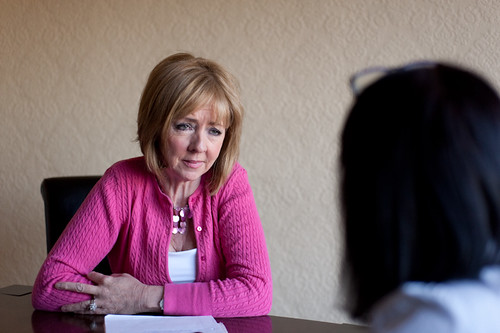 Part 2: Having lawyers that are fully committed to settlement creates better outcomes.
Part 2: Having lawyers that are fully committed to settlement creates better outcomes.
A Collaborative Divorce is one in which the husband and the wife each retain a lawyer for settlement purposes only.
Hiring a lawyer for this defined purpose has some risk. The success of Collaborative Divorce is based on the fact that, in most cases, the benefits far outweigh the risks. In order to understand why this is true, let’s look at the basic risks and benefits.
Risk: At the beginning of the case, both parties and their lawyers sign a Collaborative Commitment stating that the lawyers must withdraw if either spouse decides to fight in court. Therefore, the Collaborative Commitment creates a risk that you will need to switch attorneys during the divorce process. Indeed, that is the very idea behind the commitment.
How significant is the risk? In my experience of around 500 Collaborative Cases, the parties have had to switch attorneys approximately 5% of the time. By comparison, in my experience practicing in the traditional model (cases where the lawyers can go to court), the parties switched attorneys, or the attorneys withdrew from representation for other reasons, almost 5% of the time. So, in reality, the risk that clients need to switch attorneys by starting in the Collaborative Process may not be significantly greater than in a non-Collaborative case.
Benefits: The most significant benefit from the Collaborative Commitment is that the attorneys are free to focus all of their attention on more creative settlements. Removing, or at least significantly diminishing, the threat of court, opens the door to
interest-based negotiation. Instead of using argument, accusation and threats of court, which are taken off the table, the attorneys advocate for their clients by using creativity, empathy and the development of shared goals.
What clients seem to want, in almost all instances, is a form of advocacy (meaning protection of true interests), without creating animosity. In traditional practice, I sometimes felt like a bull in a china shop, unable to go in and help my client get what he or she truly needed, without risking damage to fragile, but important, things like the ability to co-parent and communicate effectively. Collaborative Divorce, by removing court as an immediate threat, allows me work to help my clients with far less risk to the relationship and other intangible goals.
Of course, the success of Collaborative Divorce can depend on more than just the Collaborative Commitment. Specifically, the best outcomes in Collaborative Divorce are achieved with a) a high level of commitment by the clients and 2) the skill of the professionals. The keys to success in those areas will be discussed in the next two blogs in this series. For immediate information in these areas go to
www.collaborativelaw.org or www.divorcechoice.com.
Check out Part 3 of this series, here.
 Part 5: Working with a team of professionals in Collaborative Divorce creates better outcomes.
A Collaborative Divorce is one in which the husband and the wife each retain a lawyer for settlement purposes only. In addition, in a Collaborative Divorce, the other professionals on the team, must commit to work or settlement purposes as well.
Divorce marks the end of a martial relationship and the beginning of a new life. While divorce is a legal proceeding, future success for your family may have more to do with parenting, financial planning and communication than with legal issues. While lawyers can be helpful on these additional issues, your family can generally get better assistance, at a lower cost, by turning to professionals with more skills in these other areas.
If your primary concern is how to co-parent your children in divorce, you are far more likely to gain valuable insights on how to do this by having your family work with a child specialist with the education and training in child development rather than law. If you are concerned about how to meet your expenses in both households, you are likely to get more initial benefit from working with a financial professional than with an attorney. Similarly, if your primary concern relates to difficulties in communicating with your spouse, you may want to work with a divorce coach who has the skills and training to help you focus on these important areas.
The Collaborative Divorce process is often a team process in which you work with a team of professionals rather than just with attorneys. You may initially be apprehensive about working with a team of professionals believing that it will increase your cost. However, if you plan your process carefully, working with other professionals can reduce your cost and help you create a better outcome. Generally, the work done by the financial professionals and the mental health professionals replaces much of the work done by the attorneys, allowing you to get more skilled help, generally, at a lower hourly rate.
One of the keys to success in working with a team is to make sure that you get the level of professional help that best meets the needs of your unique family. Options in working with your Collaborative Divorce Team will be discussed in an upcoming blog. However, if you want information on this now, go to www.collaborativelaw.org and www.ousky.com.
You can read the final part of this series, here.
Part 5: Working with a team of professionals in Collaborative Divorce creates better outcomes.
A Collaborative Divorce is one in which the husband and the wife each retain a lawyer for settlement purposes only. In addition, in a Collaborative Divorce, the other professionals on the team, must commit to work or settlement purposes as well.
Divorce marks the end of a martial relationship and the beginning of a new life. While divorce is a legal proceeding, future success for your family may have more to do with parenting, financial planning and communication than with legal issues. While lawyers can be helpful on these additional issues, your family can generally get better assistance, at a lower cost, by turning to professionals with more skills in these other areas.
If your primary concern is how to co-parent your children in divorce, you are far more likely to gain valuable insights on how to do this by having your family work with a child specialist with the education and training in child development rather than law. If you are concerned about how to meet your expenses in both households, you are likely to get more initial benefit from working with a financial professional than with an attorney. Similarly, if your primary concern relates to difficulties in communicating with your spouse, you may want to work with a divorce coach who has the skills and training to help you focus on these important areas.
The Collaborative Divorce process is often a team process in which you work with a team of professionals rather than just with attorneys. You may initially be apprehensive about working with a team of professionals believing that it will increase your cost. However, if you plan your process carefully, working with other professionals can reduce your cost and help you create a better outcome. Generally, the work done by the financial professionals and the mental health professionals replaces much of the work done by the attorneys, allowing you to get more skilled help, generally, at a lower hourly rate.
One of the keys to success in working with a team is to make sure that you get the level of professional help that best meets the needs of your unique family. Options in working with your Collaborative Divorce Team will be discussed in an upcoming blog. However, if you want information on this now, go to www.collaborativelaw.org and www.ousky.com.
You can read the final part of this series, here.  Part 5: Working with a team of professionals in Collaborative Divorce creates better outcomes.
A Collaborative Divorce is one in which the husband and the wife each retain a lawyer for settlement purposes only. In addition, in a Collaborative Divorce, the other professionals on the team, must commit to work or settlement purposes as well.
Divorce marks the end of a martial relationship and the beginning of a new life. While divorce is a legal proceeding, future success for your family may have more to do with parenting, financial planning and communication than with legal issues. While lawyers can be helpful on these additional issues, your family can generally get better assistance, at a lower cost, by turning to professionals with more skills in these other areas.
If your primary concern is how to co-parent your children in divorce, you are far more likely to gain valuable insights on how to do this by having your family work with a child specialist with the education and training in child development rather than law. If you are concerned about how to meet your expenses in both households, you are likely to get more initial benefit from working with a financial professional than with an attorney. Similarly, if your primary concern relates to difficulties in communicating with your spouse, you may want to work with a divorce coach who has the skills and training to help you focus on these important areas.
The Collaborative Divorce process is often a team process in which you work with a team of professionals rather than just with attorneys. You may initially be apprehensive about working with a team of professionals believing that it will increase your cost. However, if you plan your process carefully, working with other professionals can reduce your cost and help you create a better outcome. Generally, the work done by the financial professionals and the mental health professionals replaces much of the work done by the attorneys, allowing you to get more skilled help, generally, at a lower hourly rate.
One of the keys to success in working with a team is to make sure that you get the level of professional help that best meets the needs of your unique family. Options in working with your Collaborative Divorce Team will be discussed in an upcoming blog. However, if you want information on this now, go to www.collaborativelaw.org and www.ousky.com.
You can read the final part of this series, here.
Part 5: Working with a team of professionals in Collaborative Divorce creates better outcomes.
A Collaborative Divorce is one in which the husband and the wife each retain a lawyer for settlement purposes only. In addition, in a Collaborative Divorce, the other professionals on the team, must commit to work or settlement purposes as well.
Divorce marks the end of a martial relationship and the beginning of a new life. While divorce is a legal proceeding, future success for your family may have more to do with parenting, financial planning and communication than with legal issues. While lawyers can be helpful on these additional issues, your family can generally get better assistance, at a lower cost, by turning to professionals with more skills in these other areas.
If your primary concern is how to co-parent your children in divorce, you are far more likely to gain valuable insights on how to do this by having your family work with a child specialist with the education and training in child development rather than law. If you are concerned about how to meet your expenses in both households, you are likely to get more initial benefit from working with a financial professional than with an attorney. Similarly, if your primary concern relates to difficulties in communicating with your spouse, you may want to work with a divorce coach who has the skills and training to help you focus on these important areas.
The Collaborative Divorce process is often a team process in which you work with a team of professionals rather than just with attorneys. You may initially be apprehensive about working with a team of professionals believing that it will increase your cost. However, if you plan your process carefully, working with other professionals can reduce your cost and help you create a better outcome. Generally, the work done by the financial professionals and the mental health professionals replaces much of the work done by the attorneys, allowing you to get more skilled help, generally, at a lower hourly rate.
One of the keys to success in working with a team is to make sure that you get the level of professional help that best meets the needs of your unique family. Options in working with your Collaborative Divorce Team will be discussed in an upcoming blog. However, if you want information on this now, go to www.collaborativelaw.org and www.ousky.com.
You can read the final part of this series, here. 


 Working with children, I became a Harry Potter fan out of both necessity and real appreciation. J.K. Rowlings’ world of wizards and magic is a fantasy, but the themes of these books are human and real. Among the most frightening characters in Rowlings’ epic struggles of power and control, good vs. evil, are the Death Eaters and the Dementors.
Working with children, I became a Harry Potter fan out of both necessity and real appreciation. J.K. Rowlings’ world of wizards and magic is a fantasy, but the themes of these books are human and real. Among the most frightening characters in Rowlings’ epic struggles of power and control, good vs. evil, are the Death Eaters and the Dementors.